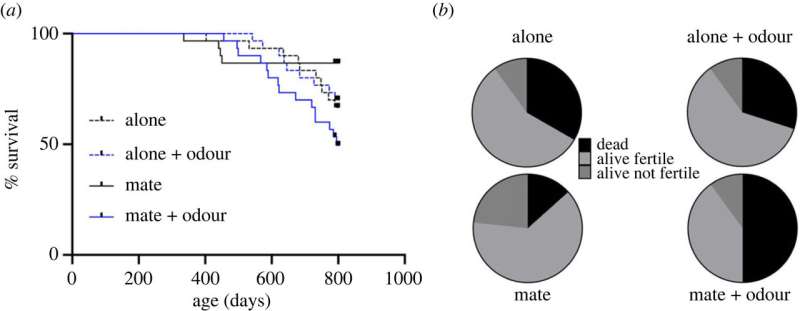This article has been reviewed according to Science X's editorial process and policies. Editors have highlighted the following attributes while ensuring the content's credibility:
fact-checked
trusted source
proofread
Female olfactory cues hasten mortality and reproductive aging, mouse study finds

Sensory cues from the opposite sex can influence how animals age, a University of Otago-led study has found.
Lead author Associate Professor Mike Garratt, of the Department of Anatomy, says research has previously shown interactions with the opposite sex can speed up aging. This study has built on that by showing sensory cues alone can drive those effects.
"This provides an example of how information detected by our sensory systems—what we see, hear and smell—can have long term effects on our bodies and even influence health and aging," he says.
For the study, published in Proceedings of the Royal Society B, researchers from Otago and the University of New South Wales tested whether exposure to female odors influenced mortality and reproductive aging in male mice.
Male mice were housed in four environments: alone; with two females; alone but with exposure to scents from two absent females; or housed with two females along with the scent of two absent females. When males were old, they were all paired with females to assess fertility.
The researchers found that males exposed to female olfactory cues (chemical smell signals) from middle to old age had reduced fertility later in life. Males exposed to female odors in conjunction with mating also showed an increased mortality rate.
It is not known why these effects occurred, but Associate Professor Garratt says the results highlight how sensory perception of mates may be an important driver of life-history tradeoffs in mammals.
Pheromone exposure is very important for mice in the context of reproduction, he says, but other cues could conceivably influence humans, such as those that cause chronic stress, which could have widespread effects on our health.
"It is known that sensory cues influence the release of hormones that can have short-term physiological effects on animals and humans. These effects can conceivably 'add up' and extend to influence our health. We should think about the environment that we live in, how we perceive it, what feelings it elicits, and take note of this as this could have long-term consequences for our bodies," he says.
More information: Michael Garratt et al, Exposure to female olfactory cues hastens reproductive ageing and increases mortality when mating in male mice, Proceedings of the Royal Society B: Biological Sciences (2024). DOI: 10.1098/rspb.2023.1848
Provided by University of Otago





















